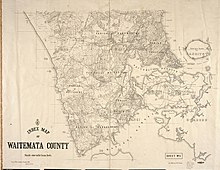Waitemata County
| Waitemata County | |
|---|---|
| County of New Zealand | |
| 1876–1974 | |
 Map of the Waitemata County in 1906 | |
| History | |
• Established | 1876 |
• Disestablished | 1974 |
| Today part of | Auckland Region |
The Waitemata County, historically also known as Waitamata County, was one of the counties of New Zealand in the North Island. Established in 1876, the county covered West Auckland, Rodney and the North Shore. The county shrunk in size between 1886 and 1954 when various urban areas on the North Shore and in West Auckland became boroughs and established their own local councils. The Waitemata County was dissolved in 1974, with the county council area being taken over by the newly established Waitemata City in the west, and by Takapuna City and Rodney Council in the north.
History
[edit]
The county was established in 1876, after the abolition of the Auckland Province, and was one of the largest counties created in New Zealand.[1] The county replaced the only previous local government system, which was a series of local road boards, which were established from 1862 onwards.[1] The county was split into six ridings: Ararimu, Manukau, Takapuna, Titirangi, Waitakerei and Weiti. The County Council offices were located at the corner of Emily Place and Princes Street in Auckland, and from February 1923 until 1963 shred the office with the Manukau County Council.[2] From 1967, the council moved to 68 Greys Avenue in Auckland.[3][4]
In 1881, the Town District Act allowed communities of more than 50 households to amalgamate into a town district. Large town districts were able to form boroughs, which had their own councils and a greater lending power.[1] Between 1886 and 1954, nine boroughs split from the county as the North Shore and West Auckland began to develop: Devonport in 1886, Birkenhead in 1888, Northcote in 1908, Takapuna in 1913, New Lynn in 1929, Henderson in 1946, Helensville in 1947, Glen Eden in 1953 and East Coast Bays in 1954.[5] The remaining county area retained a primarily rural atmosphere until the 1950s.[1] In 1953, Pine Island (now known as Herald Island) joined the Waitemata County, previously having no local government.[6]
For most of its existence, the Waitemata County was known for being undeveloped and inaccessible.[7] In the 1950s and 1960s, many areas of the county had begun to develop into rural towns and suburbs of Auckland. During this period, district offices were set up in many of these centres, including Titirangi, Te Atatū, Huapai, Silverdale and Glenfield.[8]
In the early 1960s, the Auckland Regional Planning Authority began looking for ways to better develop the county. A 1962 commission recommended replacing the county with a ward-based city in West Auckland, however after six years of appeals, this idea was scrapped.[7] When the dissolution of the county began to be discussed, a new body was proposed for the western North Shore, formed from the growing centres of Albany and Glenfield, which the ARA predicted would have a greater population than Takapuna City by 1986. The new body was voted on and the measure rejected, meaning that Albany and Glenfield would be incorporated into the City of Takapuna instead.[9]
On 1 August 1974, Waitemata City formed from the Titirangi, Te Atatū, Lincoln and Waitākere ridings.[10] The boroughs of New Lynn, Henderson and Glen Eden each decided not to join the new city.[7] The remaining ridings were split between different authorities: Kumeu Riding became a part of Rodney County, while Glenfield, Albany and Long Bay joined Takapuna City.[7][9][11]
See also
[edit]References
[edit]- ^ a b c d Reidy 2009, pp. 238.
- ^ Ringer, Bruce (September 2018). Manukau City Council’s offices (Report). Auckland Libraries. Retrieved 22 November 2023.
- ^ Rounthwaite, Valerie 1989, pp. 75.
- ^ "The New Zealand Gazette 1967" (PDF). New Zealand Government. 1967. p. 397. Retrieved 22 November 2023.
- ^ Reidy 2009, pp. 239.
- ^ Reidy 2009, pp. 240–241.
- ^ a b c d Adam, Burgess & Ellis 2004, pp. 38–39.
- ^ Rounthwaite, Valerie 1989, pp. 79.
- ^ a b Rounthwaite, Valerie 1989, pp. 84–85.
- ^ Reidy 2009, pp. 242.
- ^ Thematic Heritage Overview: AGRICULTURE/horticulture/undeveloped land/public open space 1960 - PRESENT (PDF) (Report). Auckland Council. July 2011. Archived from the original (PDF) on 1 February 2023. Retrieved 12 July 2023.
Bibliography
[edit]- Adam, Jack; Burgess, Vivien; Ellis, Dawn (2004). Rugged Determination: Historical Window on Swanson 1854-2004. Swanson Residents and Ratepayers Association Inc. ISBN 0-476-00544-2.
- Reidy, Jade (2009). "How the West Was Run". In Macdonald, Finlay; Kerr, Ruth (eds.). West: The History of Waitakere. Random House. pp. 237–256. ISBN 9781869790080.
- Rounthwaite, Valerie (1989), The Story of Rural Glenfield, Takapuna: Takapuna City Council, OCLC 37482407, Wikidata Q123499466
